Microphones and Wind*
* Presented at the 91 st Convention of the
Audio Engineering Society, New York
Jörg Wuttke, AES Member
Schalltechnik Dr.-lng. Schoeps GmbH, D-7500
Karlsruhe 41, Germany
Apart from the size and shape of a windscreen, its internal structure
has the greatest influence on its efficiency. For maximum attenuation
of wind interference it is important to distinguish between the
type of protection appropriate to pressure transducers and that
which is best for pressure-gradient designs. In the latter case,
involving directional microphones, the transducer element should
always be surrounded by an enclosed volume, which functions partly
as a pressure chamber to cancel such interference.
0 INTRODUCTION
Wind can be a serious problem for the sound engineer working outdoors.
This engineering report will concentrate mainly on the practical
aspects of this problem. For those interested in pursuing the
matter in greater detail, the references at the end of this text
list papers that deal with some fundamental scientific considerations.
Scarcely any of these, however, acknowledge the most current technologies,
which use foam. Practical applications require that we be fully
aware of the different approaches required for the protection
of pressure-gradient microphones, as distinct from pressure microphones.
1 MEASURING THE EFFECT OF WIND ON MICROPHONES
 Fig. 1. Wind generator and test set-up
Fig. 1. Wind generator and test set-up
1 This machine was designed more than
20 years ago by the man who checked the performance of microphones
[I] for the IRT (Institut fur Rundfunktechnik), which at that
time was based in Hamburg, not far from the windy coast of the
North Sea.
The problem is how to generate wind without producing extraneous
noise. Swinging the microphone from the end of its cable like
a pendulum does not produce wind with the constant character desired,
nor does it simulate wind conditions outdoors. Mounting the microphone
at the end of a rotating arm or on a moving car does create a
laminar (evenly flowing) wind, but without the varying degrees
of turbulence found in "real" wind. These methods correspond
to the situation of a microphone mounted on the end of a boom,
but this is of relatively little practical importance since in
an indoor situation one can usually slow down one's own body movements
to educe this effect, whereas outdoors any such manoeuvring will
hardly influence the wind.
One way to produce "natural" turbulent wind is to place
an obstacle in front of the transducer in a laminar wind. This
requires a complicated laboratory set-up. If a rotating arm is
used to create the laminar wind, the surrounding air should stop
moving before the obstacle-microphone combination swings around
and passes back through a given space, or the measurement will
be compromised.
In order to reach a more scientific basis for study and comparison,
several well-known European microphone manufacturers now use a
huge custom-made radial ventilator 1 to generate wind
in the laboratory (Fig. 1) . Measurements are taken at a distance
of 0. 8 m from the mouth of the machine, where the turbulence
has been found to approximate average outdoor circumstances. An
ideal speed for testing is 5 m/s (11.2 mi/h = 18 km/h), measured
with an anemometer. The microphone is oriented toward the wind
source to obtain the maximum interference.
So far, however, no general test protocol is prescribed in the
standard, 2 which continues to evolve as a result of
ongoing discussions. At present, experimenters must take note
of all the conditions that surround any set of measurements being
made if the results are to be understood and used by others.
The efficiency (damping) of a windscreen can thus be expressed
as the difference between measurements made without the screen
and with it. Special care must be taken to avoid any overload
when the microphone is measured without wind protection. If necessary,
the windspeed may be reduced to meet this condition.
The advantage of this method of indicating wind screen efficiency
is that slight variations in the wind speed or turbulence (error-free
measurement of either is not easy) have no strong or direct influence
on the result. Depending on the kind of windscreen, its damping
can even remain constant over a wide range of speeds [2]; other
windscreens whose damping is frequency dependent [3] may show
a gradually decreasing efficiency toward the higher speeds.
However, using an unprotected microphone as a reference has a
disadvantage in that the user cannot really compare two systems
to find out which combination of microphone and windscreen will
give the best results, for here the design of the microphone matters.
This might be easier to assess if the noise of the protected microphone
were referred to its sensitivity, or perhaps to the noise of a
standardised microphone. Implementing either of these approaches
requires the precise standardisation of wind speed and turbulence.
The most reliable indication of the effectiveness of a windscreen
would be obtained by always measuring the frequency spectrum of
the interference, but this is not very practical. Comparisons
become much easier if measurements can be made using a weighting
curve, in which case the difference can be expressed as the number
of decibels that corresponds to the efficiency of the screen.
Of course this number should correspond to a listener's actual
impression. Surprisingly, it seems that the A-weighting curve
is the most acceptable one for this purpose, or at any rate better
than CCIR weighting.
It should be mentioned in this context that only rarely is there
enough thought given to the weighting curves used to simplify
spectral functions. One example is the familiar specification
of microphone noise in dBA. This is good for advertising in that
it gives the lowest numbers, but it does not correspond to what
one really hears. CCIR weighting, which is specified for this
purpose, should really be used.
Finally, something must be said here about pop sensitivity. While
there is indeed some similarity between wind and popping, they
are essentially different. In fact, it is much easier to cope
with popping than with wind. Pop interference can always be expected
from a known angle. This suggests a special arrangement which
protects just one side of the microphone (Fig. 2). It should be
amply clear from this fact alone that a good pop microphone design
is not likely to be well suited for use in wind.
In order to measure a microphone's sensitivity to popping, another
device must be used in place of a wind generator [4], [5]. At
present, standardisation in this area is being dealt with in IEC
84/Working Group 16.
2 IEC 268-4, Sound system equipment,
part 4: microphones International Electrotechnical Commission,
Geneva, Switzerland (1972).
2 SENSITIVITY TO WIND AS A FUNCTION OF THE MICROPHONE
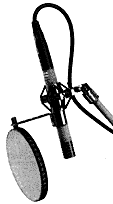 Fig. 2. Studio popscreen for speech and vocals.
Fig. 2. Studio popscreen for speech and vocals.
Different kinds of microphones react differently when used in
wind. The most important differences are those between pressure-gradient
transducers and pressure transducers. Pressure-gradient transducers
operate by sensing the difference in sound pressure between their
sound inlets. At low frequencies this difference (the gradient)
is very small.
The amplitude of the wind interference can be expressed as the
difference between any two independent vectors placed within the
circles at the end of the signal vectors in Fig. 3(a). These vectors
correspond to the different interfering "signals" at
the sound inlets of the capsule. Here the difference between them
can be larger than the sound gradient itself. Remember this when
we come to the statement that it is advantageous if the interfering
signals at both acoustic inlets are the same.
Interference-tube microphones ("shotguns") behave in
most respects much the same as conventional pressure-gradient
microphones. Most problems with wind are problems in the low-frequency
range, where shot guns are nothing more than pressure-gradient
microphones, having no higher directivity.
Pressure transducers, on the other hand, have only one inlet,
and the full amplitude of the incoming sound moves the diaphragm
throughout the audible range. So, in contrast to the pressure-gradient
transducer, the relative amplitude of wind interference is small
at any frequency compared to the amplitude of the sound [Fig.
3(b)]. Furthermore, the different operating principles underlying
the design of pressure and pressure-gradient transducers make
it necessary for the diaphragm of the latter to be less tightly
tensioned, and thus more prone to vibration and wind interference.
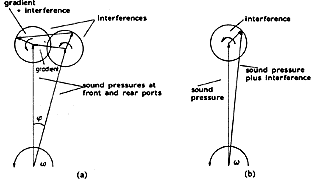 Fig. 3. Typical effect of wind interderence vectors.
(a) Added to low-frequency gradient of a pressure gradient transducer.
(b) Added to signal (pressure transducer).
Fig. 3. Typical effect of wind interderence vectors.
(a) Added to low-frequency gradient of a pressure gradient transducer.
(b) Added to signal (pressure transducer).
Unfortunately the omnidirectional character of the pressure transducer
is not the most desirable one for outdoor applications if ambient
noise is to be attenuated relative to the sound source. It is
not often recognised that this problem can be much less severe
outdoors than indoors, where multiple reflections from walls,
floor, and ceiling confuse the sound pickup. These are largely
absent outside. In any event, the power of omnis to cope with
wind should always be kept in mind for difficult outdoor situations.
The type of transducer used, such as condenser or dynamic, is
of less importance in resisting wind interference as long as the
frequency response is comparable, for the diaphragm cannot distinguish
between the air motion caused by sound pressure and that caused
by wind. The fact that many moving-coil dynamic micro phones have
relatively poor low-frequency response, and often incorporate
some kind of windscreen, some times gives the impression that
they are less sensitive to wind. In fact, the nonlinearity of
their moving-coil suspensions can act as a mechanical limiter
for excessive excursions such as those produced by wind. Moreover,
due to their low sensitivity, they will hardly overload any input.
This is also true for ribbon dynamics; but their pressure-gradient
design can be a liability outdoors.
3 SPECTRAL DISTRIBUTION AND FILTERING
 Fig. 4. Comparison of wind interference spectra for
a pressure gradient (MK 41) and a pressure transducer (MK 2).
Fig. 4. Comparison of wind interference spectra for
a pressure gradient (MK 41) and a pressure transducer (MK 2).
Fig. 4 shows the spectrum of the interference caused by wind for
two microphones of identical sensitivity. As explained, it can
be seen that the pressure transducer produces much lower noise
levels than the pressure gradient transducer. Both spectra also
exhibit their characteristic shape, with the noise amplitude increasing
as the frequency decreases. This is heard as the all too-familiar
heavy rumble.
It is easy to see why all attempts to reduce low-end sensitivity
will have a substantial effect on these disturbances. As long
as the signal transfer from stage to stage is linear, it does
not really matter where the low frequencies are attenuated. However,
in view of the high amplitudes encountered, especially in the
infra sonic range, it is not surprising that many kinds of equipment
do not remain linear.
It seems especially tragic that some portable equipment specifically
intended for outdoor recording has obviously been designed without
due regard for the fact that some very low frequencies other than
audio signals will appear at the input. These infrasonic signals,
which otherwise could easily be filtered out, drive this equipment
into nonlinearity and produce clearly audible and annoying distortion.
Small input-transformers, which are easily overloaded at low frequencies,
are often to blame in these instances.
With such equipment the high-pass filtering usually found in subsequent
stages comes too late, and so the only possible solution for the
user is to band-limit the microphone output. Several "in-line"
filters are available for this purpose, but it is difficult to
achieve a sufficiently sharp cut-off without active electronics.
(A fourth-order filter, producing a 24-dB-per-octave cut-off,
is recommended.) This is really only feasible with condenser microphones,
where the requisite powering is already provided.
4 TYPES OF WINDSCREENS
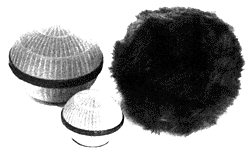 Fig. 5. Basket-style windscreens.
Fig. 5. Basket-style windscreens.
The mechanical design of a windscreen can be characterised by
its size, its shape, the materials it uses, and its internal construction.
The larger the windscreen, the more effective it will be, assuming
proper design [6], [7]. Thus the size of the windscreen will depend
on the practical limitations imposed by the intended application.
The performance of a windscreen ultimately depends on the severity
of the wind turbulence. In the rare cases where there is no turbulence,
and the wind comes from only one direction, the very best protection
will be given by a nose cone [8], but such devices must only be
used on pressure transducers.
Since (in most cases) the user has little control over the direction
from which the wind comes, the shape of the windscreen should
be aerodynamic to ensure that it does not itself generate additional
turbulence; thus the ideal form is a sphere [9]. However, given
the shape of most microphones, the spherical form is often not
as appropriate as that of a cylinder. Fortunately the efficiency
of a cylindrical windscreen comes close to that of a spherical
one [3].
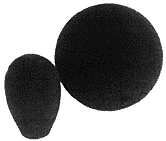 Fig. 6. Foam windscreens.
Fig. 6. Foam windscreens.
So far, most research (see references) has been carried out by
constructing an open frame and covering it with one or more layers
of cotton, fine-mesh fabric, metal screen, or the like. This type
of construction will be designated a "basket-style windscreen"
in this report (Fig. 5). The essential concept is to enclose a
volume of air around the microphone, or at least its transducer
(capsule).
Solid foam windscreens have now become very common (Fig. 6). Much
of their popularity stems from the fact that they are considerably
less delicate than the basket style, and much cheaper to produce.
Normally they fit snugly over the capsule and require no frame.
Closed pore foam must not be used [10]; open-cell foam (such as
Acoustifoam) is the appropriate choice. An ideal density is between
50 and 8Q pores per linear inch.
5 HOW DIFFERENT TYPES OF WINDSCREENS WORK
All windscreens must use materials selected for the basic purpose
of preventing the full velocity of the wind and its turbulence
from reaching the transducer. These can be various deniers of
nylon mesh stretched over a frame, metal screening, sintered metal,
or other porous materials such as open-cell plastic foam, or even
fur, which is a good absorber of turbulent energy and poses no
risk of creating any noise itself. In de signing such windscreens
where thin layers of fabric or foam are used, the risk of flutter
must be avoided. Portions of the frame must not be allowed to
create additional wind turbulence and whistling noises through
being exposed, and their acoustic influence must be minimised.
As noted earlier, the basket-style windscreen traps a volume of
air around the transducer. For practical purposes, if we regard
this volume as truly enclosed, we begin to understand why the
basket-style windscreen works especially well with pressure-gradient
transducers.
As long as the diameter of the sphere is small compared to the
acoustic wavelength, its "enclosed" part will work as
a pressure chamber, maintaining the same momentary pressure throughout.
Thus the variation in this internal pressure caused by wind interference
will be the same at the two acoustic inlets of a pure pressure
gradient transducer, and so there will be no movement of the diaphragm.
Unfortunately this same principle applies to low frequency sounds
as well, and they roll off to the degree that the windscreen is
kept small and made more effective. Of course, as noted above,
this may be considered helpful. Of greater consequence is the
loss of directivity at low frequencies, for it is the difference
between sound pressures at the two acoustic ports which, as a
function of the sound incidence, determines directivity.
At high frequencies the windscreen is no longer small in comparison
to the acoustic wavelength, and standing waves will influence
the frequency response and directivity of the capsule depending
on its placement in the windscreen. In a small windscreen, these
eigen modes interact with the acoustical impedance of the transducer,
worsening the response and polar anomalies already present. To
minimise these effects it is usually best to place the transducer
close to the center of a spherical basket-style windscreen. A
further problem of this kind of windscreen results from the deformation
of the sound field caused by its frame, which alters the microphone's
response [11] and degrades its directivity.
Foam windscreens are much simpler to construct than other types,
but conventional designs do not enclose an inner volume of air.
This is the main reason why they are not very effective when used
on pressure-gradient transducers. For pressure transducers, however,
they are perfect.
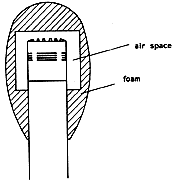 Fig. 7. Sectional drawing of a hollow foam windscreen.
Fig. 7. Sectional drawing of a hollow foam windscreen.
Since foam windscreens have no frame to cause scattering, reflection,
or diffraction from support rods and plates, they leave the sound
field relatively undeformed. Their worst effect is some rolloff
of the high frequencies, which increases with the size and density
of the windscreen. The loss of high end is a result of the volume
enclosed by each of the pores in the foam and the narrow labyrinth
that exists between them, a combination that forms an acoustic
low-pass filter. However, unlike the spectral effects produced
by basket style windscreens, this can easily be compensated for.
The positive characteristics of basket-style and solid foam windscreens
can be combined in a simple way by hollowing out the foam to form
a chamber around the capsule (Fig. 7). In this construction a
layer of thick foam replaces the one or more thin layers of fabric
covering a frame. The thickness of this foam cover tends to damp
any standing waves. On the other hand, the impedance of the foam
at low frequencies behaves less like a firmly enclosed chamber
than does a well dimensioned basket with its cover, and so more
low end noise may be expected. These effects are all illustrated
in Figs. 8-11.
Fig. 8. Wind interference with a cardioid (MK 4).
Wind speed 11.2 mi/h (18 km/h); incidence 0°.
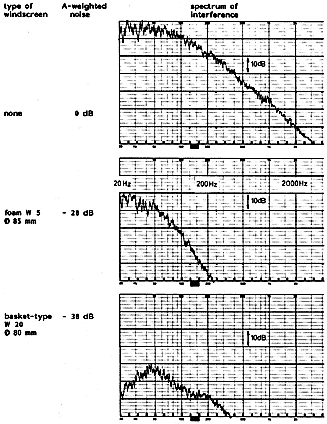
Fig. 9. Influence of different types of windscreens
on frequency response and directivity of a cardioid (MK 4).
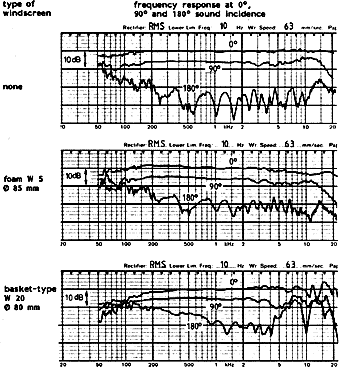
Fig. 10. Wind interference with a pressure omnidirectional
microphone (MK 2). Wind speed 11.2 mi/h (18 km/h); incidence 0°.
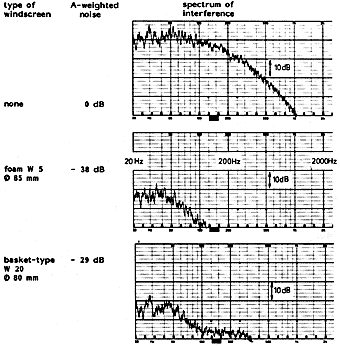
Fig. 11. Influence of different types of windscreens
on frequency response of a pressure omnidirectional microphone
(MK 2).
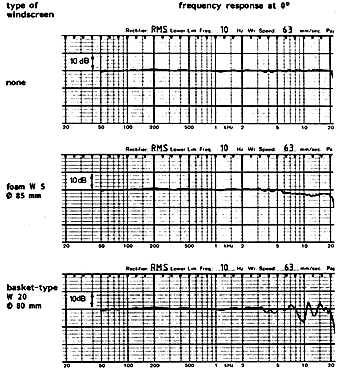
6 SOME PRACTICAL CONSIDERATIONS
As noted, the larger the windscreen, the more efficient it will
be. But practical considerations usually limit the size-too large
a windscreen may bear the user aloft-so efficiency must be gained
by other means. In a basket-style windscreen, increasing the density
of the mesh or the number of layers (or both) will accomplish
this, but at the price of increased sonic degradation. Not surprisingly,
small high-efficiency windscreens are found to have the worst
effect on the sound.
If an especially effective protection is required, the use of
another windscreen inside a basket-style wind screen can be helpful.
But the more grids, rods, and plates are involved, the more coloration
of the sound will occur. Moreover, since pressure-gradient micro
phones lose their directivity at low frequencies in pro portion
to the efficiency of the windscreen used, a pressure transducer
ought to be considered in extreme cases.
If this seems a controversial choice, consider that the otherwise
excellent low-end response of the omnidirectional microphone can
be rolled off to approximate that of a directional microphone,
in the process getting rid of potentially harmful low-frequency
disturbances. Now you can use a combination based on the transducer
with the least sensitivity to wind, one which will have a very
good sound if it is simply protected by enough foam. The smooth
high-end rolloff produced by the foam can often be compensated
for by simply selecting a diffuse-field omnidirectional microphone
with its characteristic rising high-end response.
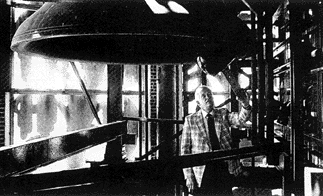 Fig. 12. Severe climatic conditions with heavy wind
are overcome by this boundary-layer microphone installation in
the bell chamber at Bok Tower Gardens. central Florida. USA. (Courtesy
of John Cress Photo.)
Fig. 12. Severe climatic conditions with heavy wind
are overcome by this boundary-layer microphone installation in
the bell chamber at Bok Tower Gardens. central Florida. USA. (Courtesy
of John Cress Photo.)
A further possibility is to use a boundary-layer technique, which
increases the pickup of direct sound by achieving a better random-energy
efficiency than an omnidirectional microphone. Its pressure transducer
with a hemispherical polar pattern suits it to many otherwise
difficult applications where a frequency-independent pickup of
high quality is important, and there is exposure to wind (Fig.
12). However, if a maximum of directivity is absolutely essential,
and you are content to have most of it exist only at high frequencies
(typical for shotguns), then do not try to improve the
wind rejection by using a solid foam windscreen placed inside
another windscreen on the transducer. That combination will be
less effective than the basket-style windscreen alone.
This is because the increased correlation between the interfering
signals that appear at the pressure-gradient transducer's inlets,
as a result of the basket's enclosed air volume, will be decorrelated
by the added foam, with its different path labyrinths leading
to the two sound inlets.
It should always be borne in mind that the more effective a windscreen
is at reducing wind interference, the more the sound pickup will
be affected. Ignoring the sound, a closed box would then be the
very best windscreen. Thus our goal must be to reach a reasonable
compromise. But we face a Herculean task when we try to reconcile
those conflicting virtues and faults by quantifying that delicate
ratio in decibels, or reducing them to a point value on some acoustic
Richter scale. The plain fact is we must decide in each instance
how much sonic deterioration can be tolerated for the sake of
minimising wind-induced noise. This is why we are considering
so carefully the various factors that bear upon this question,
recognising the inevitable trade-offs implied-and the ultimate
responsibility shouldered by the sound engineer struggling to
make the final decision on the scene.
7 CONCLUSIONS
Foam windscreens should be used wherever the protection they offer
is sufficient, for their negative effect on the sound is relatively
small and easily correctable. On pressure transducers they are
almost always the best choice.
Basket-style windscreens must be used on directional microphones
if foam types are inadequate to reduce the levels of wind interference.
They do detract from the sound and directivity of a pressure-gradient
transducer to the degree that they are small and efficient.
A good compromise between the two types is a hollow foam windscreen.
In all cases care must be taken to avoid overloading the microphone
channel ' s input electronics due to the excessive very low and
even infrasonic frequencies produced by the action of wind on
the microphone diaphragm. Attenuating the system's low-end response
at the earliest opportunity is always a good idea to ensure a
clean transmission.
8 ACKNOWLEDGEMENT
The author wishes to thank Jerry Bruck for several useful suggestions
and for "adapting and americanising" the original text,
and Louise Bloomfield for editing out his most exuberant excesses
and polishing the result.
9 REFERENCES
[1] P. Buhlert, Norddeutscher Rundfunk, Hamburg, unpublished paper.
[2] H.-J. Schubert, "Einige Betrachtungen zur Di mensionierung
von Windschutzgeraten fur Studiomikrofone" (Some Observations
on the Dimensioning of Wind Protection Equipment for Studio Microphones), Tech. Mitte. Rundfunk- und Fernsehtech. Zentralamt, vol.
12, no. 4 pp. 160-165 (1986).
[3] P. Koltzsch, "Zur W~ndgerauschdampfung von Windschirmen"
(On the Attenuation of Wind Noise by Windscreens), Hochfrequenztech.
Elektroakust., vol. 80, pp. 1-9 (1971 Feb.).
[4] E. Werner, "Dependence of Microphone Pop Data on Loudspeaker
Properties," J. Audio Eng. Soc. (Engineering Reports),
vol. 38, pp. 469-476 (1990 lune).
[5] H. Wollherr and H. Ball, "Messtechnische Bes timmung
der Pop-Empfindlichkeit von Mikrofonen" (Measurement Techniques
to Specify the Pop-Sensitivity of Microphones), in Fortschritte
der Akustik (DAGA, 1991). Tech. Mitte. Rundfunk- und Fernsehtech.
Zentralamt, vol. 12, no. 4 pp. 160-165 (1986).
[6] J. C. Bleazey, "Experimental Determination of the Effectiveness
of Microphone Wind Screens," J. Audio Eng. Soc.
vol. 9, pp. 48-54 (1961 Jan.).
[7] F. Skode, "Windscreening of Outdoor Microphones,"
Bruel & Kjaer Tech. Rev,no.
1, pp 3-10 (1966).
[8] M. Brock, "Wind and Turbulence Noise of Turbulence Screen,
Nose Cone and Sound Intensity Probe with Windscreen," Bruel
& Kjaer Tech. Rev.,no. 4,
pp. 32-39 (1986).
[9] P. Bruel, "Aerodynamically Induced Noise of Microphones
and Windscreens," Tech. Rev. (2/1960).
[10] L. Burroughs, Microphones: Design and Application (Sagamore
Publ., Plainview, NY, 1974), pp. 193- 194.
[11] P. Koltzsch, "Kleine Schallfeldverzerrungen durch Streuungs-
und Reflexionserscheinungen an Scheiben und Staben, insbesondere
an Windschirm gerustteilen" (Low Distortion of the Sound
Field by Scattering and Reflection Phenomena at Discs and Bars,
Especially at the Basket of a Windscreen), Sci. J. Tech. Univ.
Dresden, vol. 17, no. 1, pp. 131-133 (1968).
THE AUTHOR
Jörg Wuttke was born in Berlin in 1942. From an early age
he showed an interest in precision mechanics and electronics,
to which his father initially introduced him. He studied electronics
and telecommunications at Karlsruhe University, and as an indirect
result of his deep interest in music, he specialised in acoustics,
concentrating on research into loudspeakers and phonograph cartridges.
From 1967 until his graduation in 1969, he was teaching assistant
to Professor Günther Kurtze, the inventor of the shotgun
microphone. He joined Dr.-lng. Schoeps GmbH as a research engineer
in 1970, became its chief engineer in 1972 and is now its technical
director. Together with Dr. Schoeps, he holds a patent on the
Colette microphone series. He is a member of the AES and, since
1972, a member of the DIN committee on Microphones and Headphones.
He maintains an active interest in listening to and recording
live music.
 Fig. 1. Wind generator and test set-up
Fig. 1. Wind generator and test set-up
 Fig. 2. Studio popscreen for speech and vocals.
Fig. 2. Studio popscreen for speech and vocals.
 Fig. 3. Typical effect of wind interderence vectors.
(a) Added to low-frequency gradient of a pressure gradient transducer.
(b) Added to signal (pressure transducer).
Fig. 3. Typical effect of wind interderence vectors.
(a) Added to low-frequency gradient of a pressure gradient transducer.
(b) Added to signal (pressure transducer).
 Fig. 4. Comparison of wind interference spectra for
a pressure gradient (MK 41) and a pressure transducer (MK 2).
Fig. 4. Comparison of wind interference spectra for
a pressure gradient (MK 41) and a pressure transducer (MK 2).
 Fig. 5. Basket-style windscreens.
Fig. 5. Basket-style windscreens.
 Fig. 6. Foam windscreens.
Fig. 6. Foam windscreens.
 Fig. 7. Sectional drawing of a hollow foam windscreen.
Fig. 7. Sectional drawing of a hollow foam windscreen.




 Fig. 12. Severe climatic conditions with heavy wind
are overcome by this boundary-layer microphone installation in
the bell chamber at Bok Tower Gardens. central Florida. USA. (Courtesy
of John Cress Photo.)
Fig. 12. Severe climatic conditions with heavy wind
are overcome by this boundary-layer microphone installation in
the bell chamber at Bok Tower Gardens. central Florida. USA. (Courtesy
of John Cress Photo.)